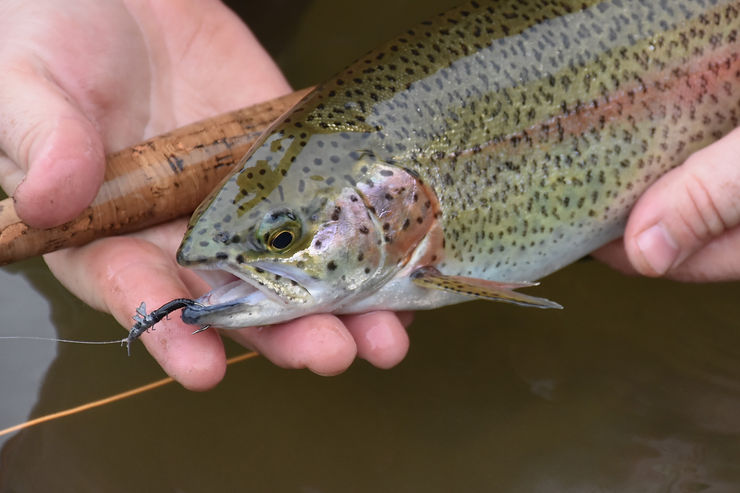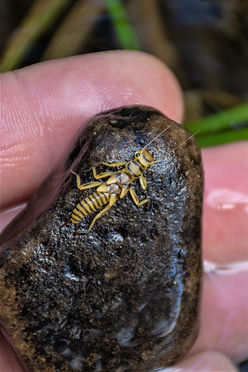Gettin’ Stoned: An Introduction to Stoneflies

Stoneflies are one of the most common aquatic insects found in trout waters throughout North America. They come in a variety of colors and sizes and they’re some of the first hatches to appear each spring. In fact, their tendency to emerge in cold weather has garnered them the nickname “the snowflake hatch.” Many times, I’ve experienced some of the best stonefly action on February days when snow flurries were in the air. It was cold, but the fish were hungry, and I enjoyed every minute of it.
Early spring stonefly hatches include three different species: Little Black Stoneflies, Early Black Stoneflies, and Early Brown Stoneflies. They range in size from 14 to 18, although occasionally they’ll run as large as size 12. Unlike mayflies, stoneflies have a lifespan of several years, so it’s common to find different age groups of the same species in a river system.
Stoneflies don’t hatch in the same manner that mayflies do, either. They migrate from deeper pools and riffles toward shore and crawl out of the water onto rocks, logs, and other debris. Stoneflies lack a pupal stage and simply split from their nymphal shucks as full-grown adults. This simplifies things for fly anglers in terms of matching the hatch because there are only two types of patterns you need to carry in your fly box, nymph and adult imitations.
Stonefly hatches are easy to miss, and many times they’re over before you realize they’ve begun. To get a sense of the status of the hatch, examine rocks along shorelines for nymphs or shucks. Once they climb up onto the bank, stoneflies can take hours or even days to transition into adults. If you’re finding nymphs, chances are excellent that the next few days will produce some quality surface fishing. If all you find are shucks, nymphing will likely provide better results.

Even when adult stoneflies are in the air, though, trout don’t always key in on them the way you’d expect. Stoneflies tend to hatch sporadically and you’ll rarely find clouds of insects in the air which means fishing a dry fly pattern isn’t always the best option. I don’t often carry a selection of stonefly dry flies, so when trout are actively feeding on the surface, I do well with an Elk Hair Caddis or Flying Ant in the same size as the naturals. Stoneflies and caddisflies have wings that lie parallel to their bodies. The biggest difference is that stonefly wings lie flat along their backs while caddis wings are more tent shaped. Regardless, I’ve had great success using a size 16 black Elk Hair Caddis during Little Black Stonefly hatches and a brown caddis during Early Brown Stonefly hatches.
Stonefly nymphs are a staple of a trout’s diet year-round. In fact, I can’t think of a time of year when I haven’t caught trout on a stonefly nymph. Even better is that trout don’t seem too finicky when it comes to the size of the imitation used. After all, at any time of year, stoneflies of all sizes can be found on the stream bottom. I take advantage of this and usually start with a pattern a size or two bigger than the naturals, and if that doesn’t work, I drop down to a smaller size. The most common colors I use are black, brown, and golden. All three in various sizes (ranging from size 6 down to size 18) will work any time of year wherever stoneflies are found.

In fast water, I like a high-stick method and no indicator, a technique that has become well-known lately as Euro-nymphing, which allows me to better manipulate the stonefly through pockets and behind boulders where feeding fish are likely to be. I prefer a weighted nymph, and sometimes I add a small split-shot about a foot above the fly to help get it to the bottom quicker in faster current. This is why I don’t use an indicator – the added weight of a split-shot in combination with the heavy current usually drags it underwater anyway. Also, in fast water, strikes can be fierce and easy to detect.
Stonefly imitations work best when they’re bounced along the bottom, so sometimes you have to experiment with different sizes of split shot that will get your fly down but not get snagged on every cast. Stoneflies can’t swim. When they feel threatened or break loose from structure, they curl up as they bounce down through the current and uncurl once they’ve settled and feel safe again.
Spring can be symbolized by many things: a date on the calendar, the gobble of a big tom turkey, or the blooming of certain flowers. But for fly anglers, it’s those early season stoneflies. They’re a rite of spring that’s not to be missed.

